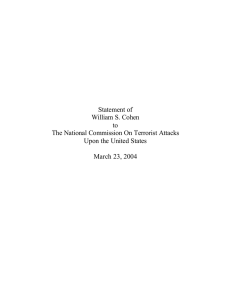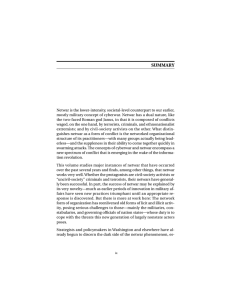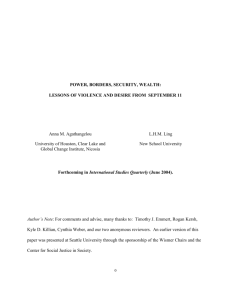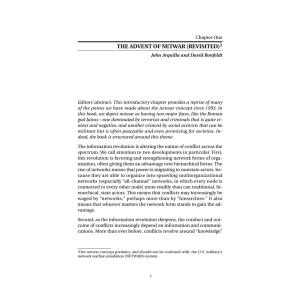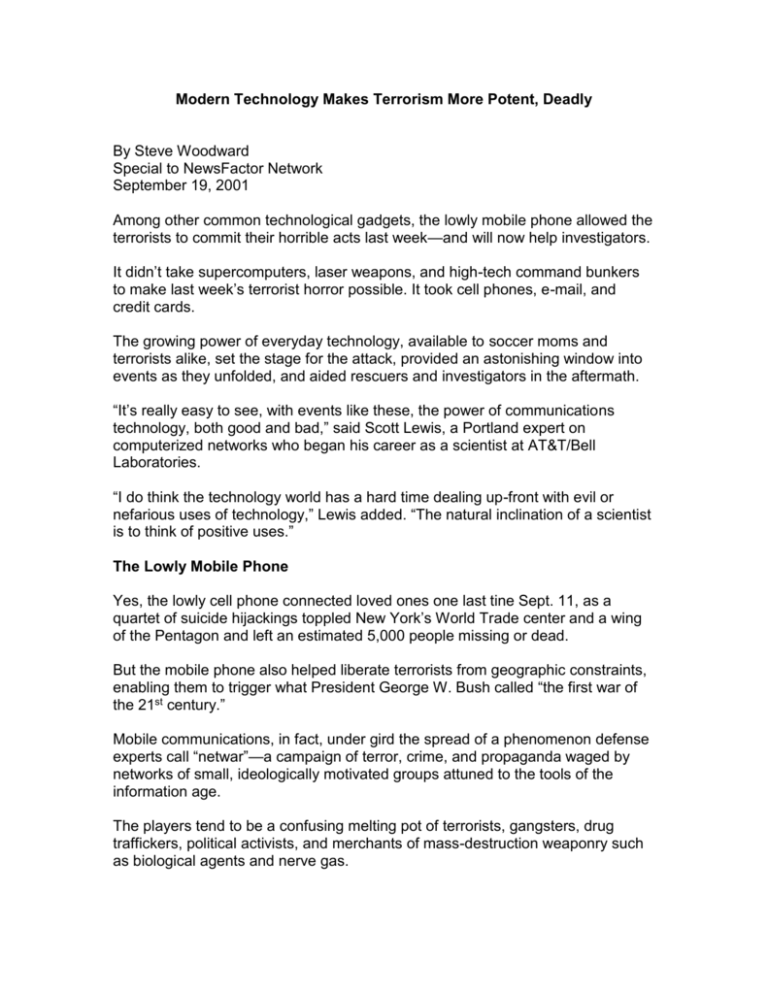
Modern Technology Makes Terrorism More Potent, Deadly
By Steve Woodward
Special to NewsFactor Network
September 19, 2001
Among other common technological gadgets, the lowly mobile phone allowed the
terrorists to commit their horrible acts last week—and will now help investigators.
It didn’t take supercomputers, laser weapons, and high-tech command bunkers
to make last week’s terrorist horror possible. It took cell phones, e-mail, and
credit cards.
The growing power of everyday technology, available to soccer moms and
terrorists alike, set the stage for the attack, provided an astonishing window into
events as they unfolded, and aided rescuers and investigators in the aftermath.
“It’s really easy to see, with events like these, the power of communications
technology, both good and bad,” said Scott Lewis, a Portland expert on
computerized networks who began his career as a scientist at AT&T/Bell
Laboratories.
“I do think the technology world has a hard time dealing up-front with evil or
nefarious uses of technology,” Lewis added. “The natural inclination of a scientist
is to think of positive uses.”
The Lowly Mobile Phone
Yes, the lowly cell phone connected loved ones one last tine Sept. 11, as a
quartet of suicide hijackings toppled New York’s World Trade center and a wing
of the Pentagon and left an estimated 5,000 people missing or dead.
But the mobile phone also helped liberate terrorists from geographic constraints,
enabling them to trigger what President George W. Bush called “the first war of
the 21st century.”
Mobile communications, in fact, under gird the spread of a phenomenon defense
experts call “netwar”—a campaign of terror, crime, and propaganda waged by
networks of small, ideologically motivated groups attuned to the tools of the
information age.
The players tend to be a confusing melting pot of terrorists, gangsters, drug
traffickers, political activists, and merchants of mass-destruction weaponry such
as biological agents and nerve gas.
Netwar moved to violent new heights last week, when 19 hijackers foiled hightech metal-detection systems with low-tech knives and box-cutters,
commandeered four Boeing airliners and turned them into impromptu, 200-ton,
human-guided cruise missiles.
Unlike traditional wars, their apparent intent was not to cripple the United States’
means of war production, but to make a political statement by striking symbolic
targets.
Numerous netwars are ongoing, with most of the 29 foreign terrorists
organizations identified by the U.S. State Department broadcasting their own
news and views worldwide through Web sites, according to Maura Conway, who
tracks the issue for Foreign Policy Association, a New York educational
organization.
Despite its military might, many defense specialists say the United States is illprepared for netwar, which favors decentralized webs of highly informed
combatants over traditional top-down military hierarchies.
U.S. defenses have long been designed to stare down a hostile Cold War
superpower, several defense analysts said. But last week’s events have changed
the rules of engagement.
The United States faces having to do what numerous commissions and
congressional subcommittees have been urging for years: Rethink how to battle
tiny, nimble enemies that are no longer afraid to strike on U.S. soil, against
civilian targets, in unconventional ways.
“Tuesday, Sept. 11, is the day the Cold War definitely ended,” said Jack
Spencer, a defense policy analyst with the Heritage Foundation, a conservative
think tank in Washington, D.C.
Weaker Enemy, Smarter Tactics
The use of imaginative tactics by a weaker but more flexible enemy to attack
large, fixed targets—military analysts call it asymmetric threat—is what WireX
Communications’ Crispin Cowan, a Portland computer security expert, described
as “21st-century guerrilla warfare.”
One of the world’s foremost netwarriors, Osama bin Laden, is suspected by the
U.S. investigators of being the mastermind behind last week’s attacks in New
York and near Washington, D.C.—or at least the attacks’ biggest supporter.
Like fellow netwarriors such as Hamas, the Islamic Resistance Movement, bin
Laden’s international Al-Qaeda network is a power user of information and
communications technology.
“The terrorist-financier has computers, communications equipment, a large
number of disks for data storage, and a communications network that relies on
the World Wide Web, e-mail, and electronic bulletin boards,” Rand Corp. analysts
wrote in 1998, citing reports from journalists who had visited bin Laden’s remote
headquarters in southeast Afghanistan.
“His headquarters is in cyberspace, you could argue,” Spencer said.
As of last week, bin Laden’s network was once again relying on modern
technology, using a satellite phone to call a Pakistani television and operate
semiautonomously without the need for a traditional leader.
Michael Whine, writing for the International Policy Institute for Counter-Terrorism,
noted that part of the Palestinian Islamic Jihad’s command-and-control system
operated out of Tampa, Fla., according to the FBI.
Moreover, terrorists have adopted sophisticated encryption technologies to
protect their Internet communication, making it ever tougher for U.S. signal
analysts to decipher their messages, experts say.
Human Intelligence
Intelligence experts point out that bin Laden, in particular, also uses oldfashioned human couriers—a low-tech redundancy that serves as a backup to
high-tech communications.
The reliance on both low and high technology stands in contrast with the United
States, which has spent the past 20 years building up its spy satellites and
electronic eavesdropping capability while scaling back its network of human
spies.
“Although America’s intelligence collection from satellites and signals intercepts
is highly effective, it has limits,” Philip Gold, a senior fellow of the Discovery
Institute think tank in Seattle, wrote in June. “The U.S. intelligence community
has relied too heavily on technology while neglecting investment in intelligence
from human sources.”
The scaling-back of low-tech human intelligence, or HUMINT in spy parlance,
has left a void that would take intelligence agencies years to fill with new,
reliable, trusted informants, industry observers say.
“If you pull HUMINT capability out of an area, it’s difficult to re-establish it,” said
Robert Ellis, president and chief executive officer of Portland-based IronSpire
and a former defense industry contractor who founded a military sensor
company.
As the United States veers toward complete reliance on technology in every
corner of its society, from finance to national defense, computers and
communications networks themselves are becoming targets.
“As our society becomes increasingly dependent on knowledge-based
technology for producing goods and providing services, new vulnerabilities to
such attacks will arise,” the U.S. Commission on National Security/21 st Century
warned in 1999.
In January, a Pentagon commission on national security in space warned that the
nation had become dependent on a space-based defense system of spy and
communication satellites that was open to attacks against ground stations,
launch systems or satellites themselves.
Information Vulnerable
And the day after last week’s terrorist attacks, Joel C. Willemssen, a high-ranking
official of the U.S. General Accounting Office, issued the latest in a series of
warnings that “federal computer systems are riddled with weaknesses that
continue to put critical operations and assets at risk” from hackers and cyberterrorists.
At the same time, the National Security Agency cautions that more than 100
nations are developing information warfare techniques that could be used against
U.S. computer networks.
Already, criminals are abandoning guns in favor of computer-based technology—
identity theft, hacking, counterfeiting and fraud—to siphon an estimated $400
billion or more each year out of the world economy, according to data provided
by Amcrin, a Portland-based high-tech anti-fraud company.
“When’s the last time you heard of a bank robbery?” said Terry L. Heilman,
Amcrin’s president and chief executive officer.
Despite the myriad vulnerabilities wrought by high technology, there’s a flip side
to the story.
Cell phones and in-seat airliner phones helped provide investigators with a
clearer picture of actions aboard the hijacked planes. Cell phones provided
passengers of hijacked United Airlines Flight 93 with information about the World
Trade Center crashes, apparently galvanizing them into a deadly battle with their
hijackers in the skies over western Pennsylvania.
Cell phones and laptop computers might have enabled World Trade Center
survivors to communicate with rescuers, according to early news reports.
A Web site jointly operated by the FBI and the National White Collar Crime
Center has generated thousands of investigative leads. High-tech DNA testing is
helping unravel identities of suspects.
And offsite computer backups enabled many companies to promptly restore data
destroyed when the World Trade Center towers collapsed.
When all is said and done, the most robust defense systems of all may be a
potent combination of high and low technology.
“As the last few years have shown,” declared the Discovery Institute’s Gold,
“among the most lethal and survivable weapons systems on Earth is an 18-yearold armed with an assault rifle and a cell phone.”
© 2001 The Oregonian i/a/w ScreamingMedia, Inc. All rights reserved.
© 2001 NewsFactor Network. All rights reserved.
http://www.newsfactor.com/perl/story/13637.html






